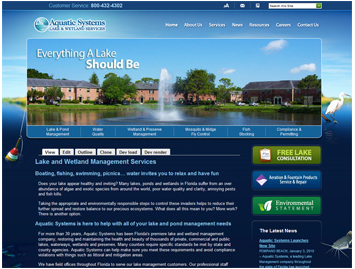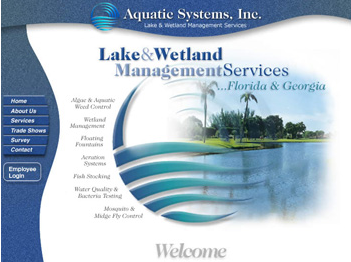Drupal Case Study – Technical Overview of Aquatic Systems
Aquatic Systems is one of the leading Lake and Wetland Management companies in the state of Florida. They restore and maintain private, commercial and public lakes, waterways, wetlands and preserves from overgrowth of algae and exotic species, poor water quality, and fish kills. Their former site was a 10-page static HTML site. Their goal was to not only update the look of their website, but to be able to add press releases, articles, and case studies in order to become the online resource for their industry.
Drupal Modules Used
- Admin Role
- Admin Menu
- Advanced Forum
- Advanced Help
- CCK
- Google Analytics
- ImageCache
- ImageField
- IMCE
- IMCE_WYSIWYG
- Nice Menus
- Nodeaccess
- Nodeclone
- Nodequeue
- Nodewords
- Page Title
- Pathauto
- Poormanscron
- Printer-Friendly Pages
- Read More Link
- Sitemap
- Vertical Tabs
- Views
- Views Slideshow
- Webform
- WYSIWYG-2.x-dev (for CKEditor)
- XMLSitemap


Theming
We started by creating a beautiful custom-designed theme. The Drupal Zen theme was used as a base in order to take advantage of the built in CSS hooks already provided, and did the theming entirely in CSS. The only change we made to the template file is to move the scripts include to the bottom of the page, just above the closure, for speed concerns. We also used Nice Menus for the dropdown menus, which provide a nice base for cross-browser compatibility.
We also utilized Views, Views Slideshow, and Nodequeue to produce a sliding banner on the homepage. We do this instead of flash for the flexibility and accessibility. The client can now control both the panels that display, as well as the order they display in, from within the Drupal administration. The flexibility that Views Slideshow provides allowed us all the flexibility that jQuery’s Cycle plugin allows.
Content Types
We included 14 different content types, which mainly reflect the sections of the site. We did it this way, as opposed to using taxonomy, for two reasons. First and foremost, we’ve found in our past experiences that users have an easier time grasping sections by content type rather than making pages and selecting taxonomy for where the page belongs. Secondly, by doing it this way, we provide a way to allow permissions to be set to only allow people to create certain types of content. We use this for their internal pages, which have a few content types that can be created by HR, but then preventing HR from editing other sections of the website.
For editing by non-developers, we included the dev version of the WYSIWYG module, which includes support for CKEditor. CKEditor is our current favorite rich text editor for Drupal. We also included IMCE for the ability to upload and select images from within the server. We also applied patch 533168-1 from the IMCE_WYSIWYG queue in order to access IMCE from within CKEditor.
We also used Printer-Friendly pages in order to help share websites without necessarily hooking into social media. This module provides a simple way for a user to send a link via e-mail, which we feel works well for corporate environments.
Conclusion
Drupal and South Florida Web Studio have provided Aquatic Systems with a flexible content management system that will grow as their business expands further. In addition, by using Drupal and utilizing existing contrib modules, SoFlaWeb was able to complete the project efficiently, both on time and within budget.
Categorized in: Drupal, Sofla Web Studio
Published On: Feb 17, 2010
